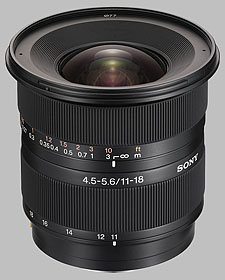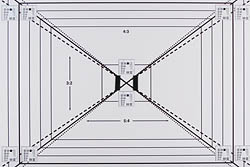| 11-18mm |
$798 average price |
|---|---|

|
|
Your purchases support this site
Buy the Sony 11-18mm f/4.5-5.6 DT SAL-1118
SLRgear Review
March 8, 2009
by Andrew Alexander
The Tamron 11-18mm made waves at PMA 2005 as one of the first off-brand ultra-wide lenses specifically made to fit the APS-C-sized subframe sensor of digital SLR cameras. A year later, Minolta produced a lens with striking similarities - right down to the exact weight of the lens. After Minolta merged into Sony, it was no surprise to see a Sony-branded version of the lens emerge with the Alpha 100 camera in August 2006.
The 11-18mm ƒ/4.5-5.6 is designed to fill the APS-C frame. The lens does mount on the full-frame A900, producing significant vignetting in the corners, however, after 15mm, this vignetting is no longer an issue. On a sub-frame dSLR camera body the lens will produce an equivalent field of view of 16.5-27mm.
To economize and create a more efficient design, the lens is equipped with a variable aperture; as the zoom extends the focal length, both the smallest and the largest apertures change. The following chart represents the largest and smallest apertures you can expect at a given focal length:
| Focal length | 11-13mm | 14-15mm | 16-18mm |
| Largest aperture | ƒ/4.5 | ƒ/5 | ƒ/5.6 |
| Smallest aperture | ƒ/22 | ƒ/25 | ƒ/29 |
The Sony 11-18mm ƒ/4.5-5.6 DT comes with a petal-shaped lens hood, and is available now for around $650.
Sharpness
The 11-18mm offers sharp results in the central portion of the frame through its entire focal range, with the aperture set at ƒ/11 and below. Diffraction limiting sets in noticeably at ƒ/16, and fully-stopped down apertures (ƒ/22 and smaller) produce noticeably soft results.
Soft corners are a problem for the 11-18mm, at every aperture and focal length - more so in some settings than others. Where it is sharp, in the center of the frame, it's impressively so - around 1-1.5 blur units between ƒ/4.5-ƒ/8 at most focal lengths - but it's a fairly small sweet spot that degrades gracefully to an average of 4 blur units, depending on the focal length and aperture setting.
The best trade-off between corner softness and central sharpness occurs at ƒ/5.6. Corner softness is slightly reduced at ƒ/8, but so is central sharpness. Most of these differentials are in the order of a single blur unit, so it's not likely you'll see the difference between aperture settings.
Chromatic Aberration
The 11-18mm ƒ/4.5-5.6 produced some of the higher results for chromatic aberration we've seen in a while. Its average CA performance - what you'd see throughout the majority of the frame, is fairly good, in the order of 3/100ths of a percent of frame height. But in the corners we see very noticeable red/green fringing, literally going off the chart at 18mm.
CA performance for this lens is related more to the focal length selected rather than the aperture setting, though the results are slightly better with larger apertures.
Shading (''Vignetting'')
Light falloff is slightly noticeable with this lens, but not objectionably so. When used at its widest aperture setting, the corners are a half-stop darker than the center. Below 15mm, at any other aperture, the corners are a third-stop darker. At any other setting, you're looking at a differential of a quarter-stop.
Distortion
As a wide-angle lens, barrel distortion is to be expected. The Sony 11-18mm ƒ/4.5-5.6 produces significant barrel distortion at 11mm (+0.8% in the corners, +0.5% everywhere else). As the lens is zoomed closer to 18mm, this distortion reduces gradually, but never goes away completely. By 18mm the lens produces +0.3% barrel distortion in the corners, and +0.1% distortion otherwise.
Autofocus Operation
The 11-18mm ƒ/4.5-5.6 shows its age slightly by using a mechanical focusing system, which is comparatively slow and noisy. It takes about 1.25 seconds to focus completely from close-focus to infinity and back, but it does seem slightly faster when performing shorter-range focusing operations. The front lens element doesn't rotate during autofocus, but the focusing ring does, so keep your fingers clear.
Macro
You wouldn't flock to this lens for its macro capabilities - 0.12x magnification (1:8 reproduction). But it does focus quite close, at 25cm (around ten inches) from the sensor plane.
Build Quality and Handling
The Sony 11-18mm ƒ/4.5-5.6 is nicely finished in the standard Sony flat black. It's small and light, owing to its plastic construction, but there is no flexing or rattling to be found. It uses a metal lens mount, and plastic filter 77mm threads. There are no switches on the lens - manual focus override is conducted solely on the camera body.
The lens is equipped with an etched distance scale, measured in feet and meters. There is no depth of field scale - not that it would be of much use on an ultrawide lens - nor is there an infrared index marker.
The zoom and focus rings use a ribbed design, running parallel to the length of the lens, however without a difference in texture, and a similar size, it's easy to mistake one ring for the other. You just have to get used to it. The zoom ring is slightly wider at 3/4'', and the focus ring, mounted at the end of the lens, is just over 1/2''.
The zoom ring doesn't take much force to turn, but not too little - in other words, it's just right. Zoom creep isn't an issue with this lens, and even if it was, the lens only extends by 1/4'' at the 18mm end of its focal length spectrum. The zoom ring requires about 75 degrees of turning action to go through the entire focal range.
As noted previously, the focus ring turns during autofocus operations. If you want to focus manually, you must disengage autofocus control with a camera setting. There is plenty of play in the manual focus ring - part of the reason the autofocus is so slow - it takes about ninety degrees of turning action to go through the focus range. The focus action has hard stops at both ends of its range, and will focus a little bit past infinity.
The lens ships with a petal-shaped lens hood, which attaches with a bayonet mount and reverses on the lens for storage. When mounted, the hood adds 1 1/4'' to the overall length of the lens. The interior of the hood is ribbed, but as is the case for wide-angle lenses, offers very little lens shading when used at wide angles.
As is the case with most wide-angle lenses, using the pop-up flash will produce a shadow on the lower portion of the image.
Alternatives
Tamron 11-18mm ƒ/4.5-5.6 Di II LD Aspherical IF SP AF ~$550
We've tested Tamron's version of this lens; it's significantly sharper, and corner softness isn't as much of an issue. Whether that's a quality control issue on Sony's part for our lens sample, or Tamron's optical formula is a question we can't answer. Corner shading is also slightly lens prominent, but chromatic aberration and distortion performance are almost identical.
Sigma 10-20mm ƒ/4-5.6 EX DC HSM ~$450
Sigma offers the 10-20mm lens in the Minolta mount, and its performance is significantly better than the Sony 11-18mm. In addition to offering more range on both ends of the focal length spectrum, the lens is much sharper, and as it is a rectilinear design, offers better distortion and less corner softness. It is especially resistant to chromatic aberration (above 10mm), and with its HSM motor, is much quieter to focus. Finally, it's less expensive.
Sigma 10-20mm ƒ/3.5 EX DC HSM ~$?
We haven't tested this lens, but if it's anything like its ƒ/4-5.6 sibling, it should be very impressive.
Konica Minolta 11-18mm ƒ/4-5.6 D AF DT ~$?
Lastly, if you can find a used copy of the KM version of this lens, it's entirely possible you will find the exact same performance.
Conclusion
The Sony 11-18mm ƒ/4.5-5.6 is respectably sharp in the central region of the frame, even when used wide open, but its design produces corner softness and barrel distortion. Chromatic aberration is quite high, even for a wide-angle lens, and its lack of a modern autofocus motor makes it somewhat slow to focus, and noisy.
It's hard to recommend the Sony 11-18mm with the newer, better-performing and less expensive Sigma 10-20mm ƒ/4-5.6 lens hovering on the sidelines. As well, Tamron's own 11-18mm ƒ/4.5-5.6 exists as another budget alternative, not to mention the older Konica-Minolta version; there are plenty of ways to get the performance this lens offers, without spending top dollar. But for the brand-loyal, the 11-18mm ƒ/4.5-5.6 offers pleasing wide-angle performance.
Sample Photos
The VFA target should give you a good idea of sharpness in the center and corners, as well as some idea of the extent of barrel or pincushion distortion and chromatic aberration, while the Still Life subject may help in judging contrast and color. We shoot both images using the default JPEG settings and manual white balance of our test bodies, so the images should be quite consistent from lens to lens.
As appropriate, we shoot these with both full-frame and sub-frame bodies, at a range of focal lengths, and at both maximum aperture and ƒ/8. For the ''VFA'' target (the viewfinder accuracy target from Imaging Resource), we also provide sample crops from the center and upper-left corner of each shot, so you can quickly get a sense of relative sharpness, without having to download and inspect the full-res images. To avoid space limitations with the layout of our review pages, indexes to the test shots launch in separate windows.
Sony 11-18mm f/4.5-5.6 DT SAL-1118
Your purchases support this site
Sony A-mount - Black
Sony 11-18mm f/4.5-5.6 DT SAL-1118 User Reviews
The Sony 11-18mm f/4.5-5.6 DT SAL-1118 doesn't have any user reviews yet!





